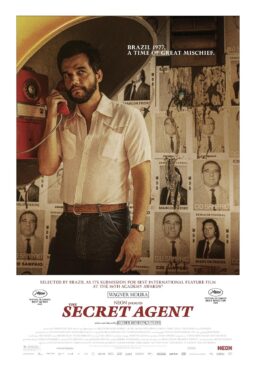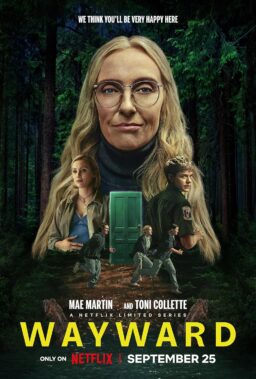 Every and each year, I take a day to watch The Godfather trilogy back-to-back-to-back. If I manage to do that more than once a year, I feel even better about myself. I’ve been deeply in love with these films since I first discovered them so many years ago – and every time someone asks me what’s my favorite movie (a question that a film critic hears quite often), I never hesitate before answering “The Godfather – all nine hours of it”.
Every and each year, I take a day to watch The Godfather trilogy back-to-back-to-back. If I manage to do that more than once a year, I feel even better about myself. I’ve been deeply in love with these films since I first discovered them so many years ago – and every time someone asks me what’s my favorite movie (a question that a film critic hears quite often), I never hesitate before answering “The Godfather – all nine hours of it”.
In the last couple times I watched them, I realized I’m starting to cry earlier and earlier during the first film: as soon as I see Michael (Al Pacino) and Kay (Diane Keaton) arriving at Connie’s (Talia Shire) wedding, the tears show up in response to the contrast their youth, happiness and love establish with the tragedy their future holds for them.
But if there’s something that always amazes me in the trilogy is its capacity of surprising me even after… what?… 20 visits? 30? Sometimes, it’s a minor insight about its structure – as when I first realized that in the first two films Tom Hagen (Robert Duvall) has to tell his Don about the death of a child (in Part I, that of Santino to Don Vito; in Part II, about Kay’s abortion to Don Michael). Sometimes, it’s a realization regarding the particular relevance of an specific moment (I’ve written in my blog about how I consider Santino’s line to Sollozzo “Whoa, now, you’re telling me that the Tattaglias guarantee our investment without…?” as the most important one in the whole trilogy).
The last time I watched the films, however, I was struck by Kay’s clothes.
(Note: the color of her costumes change somewhat dramatically depending of the media: in VHS/DVD, they’re mostly orange; in Blu-ray, the red becomes more evident.)
Yes, it would be impossible not to notice her dress when she visits the Corleone compound while looking for Michael (who’s hiding in Sicily) – its intense orange/red color basically screams against the grey and the black usually seen on the clothes of her boyfriend’s family. And it’s pretty clear the idea behind this choice is to stress how distant Kay is from the dark universe of the Corleones.
But if you pay close attention to how Kay’s clothes change during the three films you’ll realize how brilliant the visual logic of the trilogy is.
Showing a weakness for orage/red tones on her clothing from her very first scene, Kay is always seen wearing costumes dominated by those colors during the sequences in which she’s still a single woman.
During Connie’s wedding:
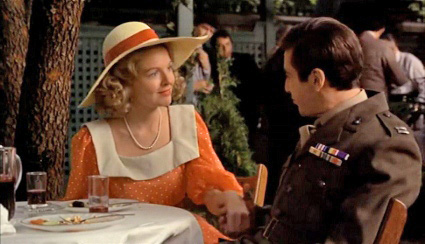
When showing Michael the headlines about Don Vito’s shooting (notice her dress under her coat):
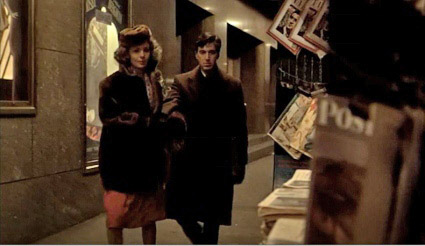
In her last dinner with Michael before he gets involved in the Family’s business (they’ll only meet again years later):

When visiting the Corlone’s house looking for information about Michael:

We’ll only meet her again when Michael, back from Italy, looks for her in the school she works for (and that’s the only scene during which her clothes don’t have orange/red details). Once again seduced by her ex-boyfriend and his promise of making the Family “legitimate”, Kay marries Michael and, when we see her again, her clothes gradually start losing her trademark color, symbolizing the harmful effect of the Corleones on her personality and on her life (and there lies the brilliance of Coppola and of costume designer Anna Hill Johnstone). Notice, for instance, the orange/red details on her belt (also present on her hat) during the scene she tells Michael he’s been invited to be godfather to Connie and Carlo’s son:

During the baptism itself, all orange/red has left her costume, although she still shows a final attempt to hold to her old vitality through her very faint lipstick:

Her efforts, however, don’t resist to Michael’s destructive force – and so, when we arrive at the final scene, all color has been completely drained from her life and from her clothes:
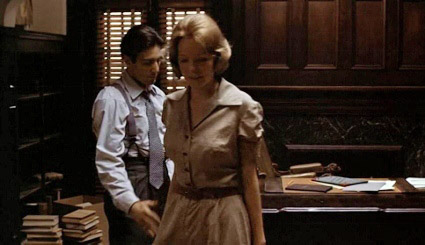
That, in itself, would be enough to applaud the visual logic of the her costume design. But then, during Part II, Coppola proves he hasn’t forgotten about it – and I literally lost my breath when I first noticed this. After years of living under the weight of the Corleone Family and her husband’s unfulfilled promises, Kay completely loses the hope of seeing Michael redeeming himself and going back to being the idealistic young man she first met. So, when he comes back from the long trip that keeps him away from her through most part of the second film, he finds Kay alone in their house. In that moment, although he doesn’t know it yet, Kay had already decided to end their marriage and she even had had an abortion.
After a long effort, she was determined to go back living and to move away from the Corleones.
And what’s the color of the clothing she’s seeing sewing in that precise moment?
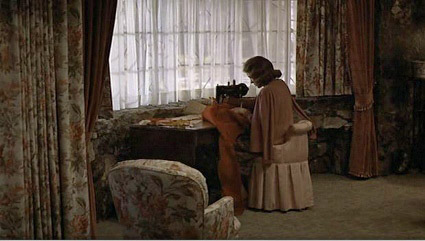
Exactly. How not to love those films?
But Part III is not different in this aspect (and I’m always amazed by how underestimated is this brilliant conclusion to the trilogy): after being denied access to her children for years, Kay is now a much stronger woman, although also a sadder one – and so, when we first meet her in the third film, her clothes reflect that. They’re not as dark as those of the rest of the Corleone family, but they’re muted in their brownish tones.
We can see that during the celebration that opens the film:

When she visits Michael in the hospital:

And when she arrives in Sicily:

That’s when Michael takes her to visit his father’s town and, once again, she’s seduced by her old lover – and his effect is immediately represented in her clothes:

And the result, of course, is the usual one when it comes to the Corleones: tragedy and loss.









